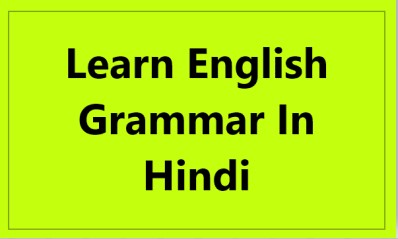Learn English Grammar In Hindi | हिन्दी में इंग्लिश ग्रामर सीखे (english grammar learning in hindi, learn english grammar online free, learn english grammar book, learn english tenses in hindi, english grammar in hindi pdf, english grammar in hindi translation, tense in hindi to english pdf, english grammar in hindi meaning, tense in hindi pdf, english grammar in hindi book).
अंग्रेजी ग्रामर (व्याकरण) को समझने के लिए हमें इसके बुनियादी नियमों और संरचना को जानना ज़रूरी है। यहां पर मैं आपको आसान भाषा में अंग्रेजी ग्रामर के मुख्य हिस्सों को समझाऊंगा।
1. वाक्य की संरचना (Sentence Structure)
वाक्य के तीन मुख्य हिस्से होते हैं:
- Subject (कर्ता): वाक्य में कौन कार्य कर रहा है।
- Verb (क्रिया): वाक्य में क्या कार्य हो रहा है।
- Object (कर्म): कार्य किस पर हो रहा है।
उदाहरण:
- Ram eats an apple.
- Ram (Subject), eats (Verb), an apple (Object)।
2. Parts of Speech (भाषा के अंग)
अंग्रेजी में 8 मुख्य Parts of Speech होते हैं:
- Noun (संज्ञा): व्यक्ति, स्थान, वस्तु या विचार का नाम।
- Example: Ram, Delhi, Table, Happiness।
- Pronoun (सर्वनाम): संज्ञा की जगह प्रयोग होने वाले शब्द।
- Example: He, She, It, They।
- Verb (क्रिया): क्रिया या कार्य को दर्शाने वाले शब्द।
- Example: Run, Eat, Speak।
- Adjective (विशेषण): संज्ञा या सर्वनाम की विशेषता बताने वाले शब्द।
- Example: Beautiful, Tall, Red।
- Adverb (क्रिया विशेषण): क्रिया, विशेषण या अन्य एडवर्ब की विशेषता बताने वाले शब्द।
- Example: Quickly, Very, Always।
- Preposition (संबंधबोधक): किसी वस्तु, व्यक्ति या स्थान का अन्य शब्दों से संबंध।
- Example: In, On, At।
- Conjunction (संयोजन): दो शब्दों, वाक्यांशों या वाक्यों को जोड़ने वाले शब्द।
- Example: And, But, Because।
- Interjection (विस्मयादिबोधक): भावनाओं को व्यक्त करने वाले शब्द।
- Example: Wow! Oh! Hurrah!
3. Tenses (काल)
अंग्रेजी में तीन मुख्य काल होते हैं:
- Present Tense (वर्तमान काल):
- Simple Present: I eat.
- Present Continuous: I am eating.
- Present Perfect: I have eaten.
- Present Perfect Continuous: I have been eating.
- Past Tense (भूतकाल):
- Simple Past: I ate.
- Past Continuous: I was eating.
- Past Perfect: I had eaten.
- Past Perfect Continuous: I had been eating.
- Future Tense (भविष्य काल):
- Simple Future: I will eat.
- Future Continuous: I will be eating.
- Future Perfect: I will have eaten.
- Future Perfect Continuous: I will have been eating.
4. Articles (A, An, The)
- A/An का प्रयोग किसी वस्तु के सामान्य उल्लेख के लिए होता है।
- Example: A dog, An apple।
- The का प्रयोग किसी विशेष वस्तु के लिए होता है।
- Example: The sun, The Taj Mahal।
5. Active और Passive Voice
Active Voice: कर्ता वाक्य में मुख्य होता है।
- Example: Ram eats an apple.
Passive Voice: कर्म वाक्य में मुख्य होता है।
- Example: An apple is eaten by Ram.
6. Direct और Indirect Speech
- Direct Speech: किसी के कहे शब्दों को ज्यों का त्यों कहना।
- Example: He said, “I am happy.”
- Indirect Speech: किसी के कहे शब्दों को अपने शब्दों में कहना।
- Example: He said that he was happy।
7. Modal Verbs (सहायक क्रियाएँ)
Can, Could, Will, Would, Shall, Should, May, Might, Must आदि का प्रयोग।
- Example:
- Can: I can swim.
- Should: You should study.
8. प्रश्न बनाने के नियम (Questions Formation)
साधारण प्रश्न:
- What, Where, When, How का प्रयोग।
- Example: What is your name?
हां/नहीं वाले प्रश्न:
- Auxiliary verb + Subject + Main verb।
- Example: Are you coming?
अभ्यास करने के टिप्स:
- हर दिन नया सीखें: Parts of Speech और Tenses से शुरुआत करें।
- अंग्रेजी में पढ़ें: किताबें, समाचार, या ऑनलाइन सामग्री पढ़ें।
- लिखें: रोज़ छोटे-छोटे वाक्य लिखने की आदत डालें।
- बोलें: खुद से अंग्रेजी में बात करने का अभ्यास करें।
